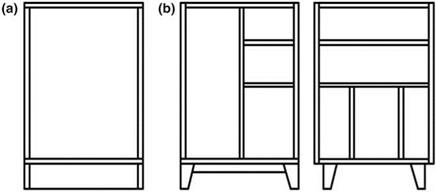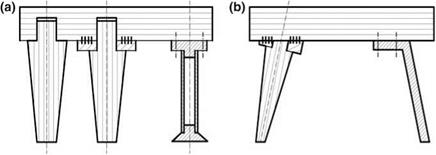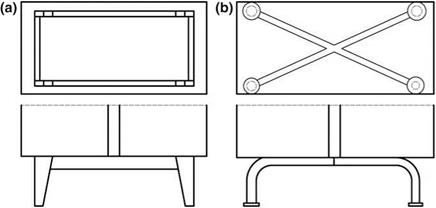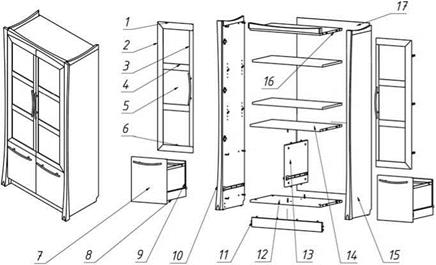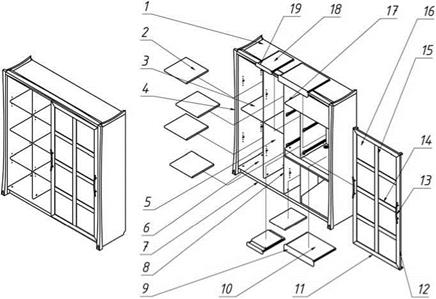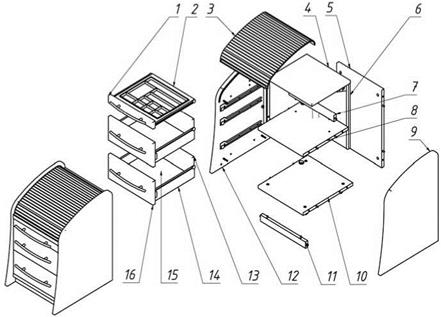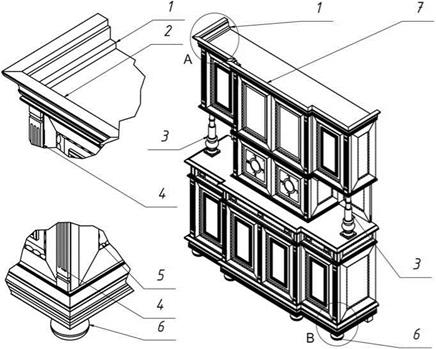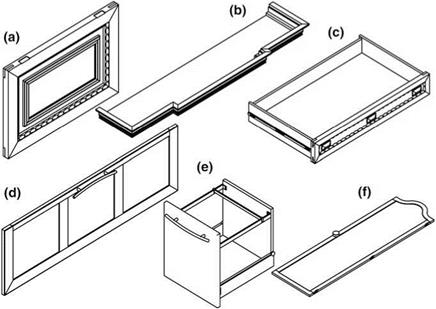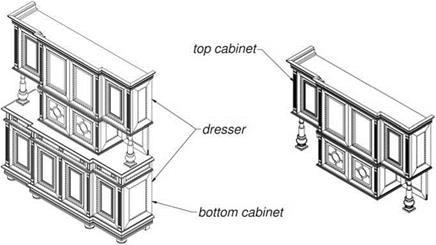Case furniture is the goods of a volume structure, in which the surface elements limit and close a given space. Among the large group of elements of a case furniture piece, we distinguish:
• the main element, without which the furniture piece loses its functional nature and the construction becomes a mechanism,
• a supplemental element, without which the construction can be maintained, but the furniture piece does not perform the intended functions and
• compensation element, without which the function and the construction can be preserved; however, its use significantly improves the stiffness, strength, durability and reliability.
![]()
|
|||
|
|||
|
|
||
|
|||
|
|||
|
|||
|
|||
|

|
Fig. 2.18 Body of the furniture piece: a single-chamber, b multi-chamber |
• internal, visible in the open furniture piece at a normal position of use. These include the interior surfaces of cabinets, couch chests, drawers and other containers,
• invisible, invisible in the furniture piece at a normal position of use. These also include external surfaces of tops situated at a height not exceeding 1.8 m and bottoms situated at a height no less than 0.9 m from the floor.
Usually, the body of the case furniture piece consists of two side panels, a bottom, a top, partitions and a rear wall. Depending on the number of partitions dividing the space into functional usable areas, we divide the bodies into (Fig. 2.18):
• single-chamber and
• multi-chamber.
The body of the furniture piece can be supported on a frame, stand on rests being an extension of the side walls and can be raised on a socle or rest directly on the floor. Each of these types of structures significantly determines the strength and durability of the furniture piece. This also affects the essential design qualities of the product, harmony of shapes and proportion of dimensions. Usually, furniture mounted on slender, towering frames has a lightweight construction, elegance of form and freedom of use. However, if the body rests on a minute frame, massive socle or directly on the floor, it is usually associated with a heavy form and limited functionality.
The legs of case furniture are made of wood, plastic and metals (Fig. 2.19). Usually, they are attached directly to the underside, perpendicular to its surface. Such fitting provides the legs an axial load and high shearing strength. A disadvantage of this kind of support of the body is the small resistance to lateral forces, causing destructible bending moments at their base. Therefore, in order to obtain an interesting aesthetic effect, they are often designed as cast, welded or moulded elements.
|
Fig. 2.19 Legs supporting the body of the case furniture piece: a perpendicular fitted wooden or metal legs, b wooden, metal or plastic legs situated obliquely to the underside |
The frames of case furniture most often have two or more legs. They are made of wood, metal, plastic and wood-based materials. Due to the structural bonding of the legs in a uniform frame, from the point of view of durability, the frame constitutes a far preferable solution than single legs (Fig. 2.20).
The base of the furniture in the form of a socle is a mechanically very effective bearing structure. Depending on the number of elements, the following socles have been distinguished (Fig. 2.21):
• three-element,
• four-element and
• five-element.
Three- and four-element socles not only serve an important supporting function, but also improve the stiffness of the body of the furniture piece usually by about 5 %. A five-element socle has an additional lateral element which improves the stiffness
|
Fig. 2.20 Frames supporting the body of the case furniture piece: a wooden, b metal or plastic |
|
Fig. 2.21 Types of socles: a three-element, b four-element, c five-element |
of the body by even up to 100 %. This is due to the fact that most of the elements of the furniture piece’s body during natural exploitation are subject to torsion, while the lateral element is subject to bending, which is why the indicator for resistance to bending is used, not for torsion.
Storage in case furniture is enabled by an appropriate number of compartments, shelves, cases and drawers. As elements fixed permanently to the body of the furniture piece, compartments have an impact on its stiffness and strength. The increase in the number of horizontal or vertical compartments clearly leads to a reduction in the thickness of the main and complementary elements. The shelves are movable elements, not permanently bonded with the body of the furniture piece, and in the calculation of the construction’s stiffness, it is not taken into account in total equations. However, due to the fact that they carry significant loads, their number indirectly affects the stiffness of the piece of furniture. Indeed, at a specific constant stiffness of the construction, the increase of load causes a linear increase of the displacement of corner nodes of the construction.
Cases and drawers, like shelves, are movable parts (subassemblages) of box furniture and are not included in the calculations of stiffness. Safety of use of furniture for storage requires that all movable elements are protected against ejecting. To this end, for shelves, special supports are applied that prevent movement in the horizontal plane, and for cases and drawers, there are stoppers halting the container after it slides out of the inside of the body to a certain point. For aesthetic reasons, the fronts of cases and drawers can be entered into the body, harmonised with narrow planes of side walls and partitions or placed on these surfaces (Fig. 2.22). For the same reasons, they are done in the same way as other
|
Fig. 2.22 Ways of inserting the fronts of drawers and doors to the body of the furniture piece: a inserting, b harmonising, c applying on |
elements of the front, that is doors, flaps or covers, referring to their design, structural form and technology of finishing.
Like the fronts of drawers, doors can be entered into the body, harmonised with narrow planes of side walls and partitions or placed on these surfaces. Access to the interior of the body is possible by turning or sliding the door. Usually, the rotation of the door, made in the form of boards or panels, takes place on the horizontal or vertical axis, while sliding takes place vertically or horizontally along appropriate straight runners. An interesting variation of a door is blinds, which are made of thin wooden strips glued to a canvas, plastic (PVC ABS, polypropylene) lamellas or aluminium lamellas joined by hinges. Blinds can run in horizontal and vertical runners, in which movement track can be either a straight line or any curve composed of many gentle arcs.
The construction of a case furniture piece is a kind of bonding of its volume, surface and linear elements in a way that is appropriate and enables safe use. It consists of elements, subassemblages and assemblages.
An element of a case furniture piece is a single part made from one material or a few kinds of materials permanently bonded with one another, e. g. top or bottom, side wall or front of drawer veneered with natural veneer.
A subassemblage is an assembled set of elements, which constitute a separate whole during the phase of assembly of the furniture piece, e. g. the socle, body and panel-structured door.
An assemblage is a set of assembled subassemblages or subassemblages and elements, constituting a separate structural unit, fulfilling most commonly a specific function in the piece of furniture, e. g. a top extension on a dresser, a top shelf on a cabinet, a cabinet which is a constituent part of a cabinet and buffet.
Designing furniture, in engineering activities, comes down to the careful design of construction documentation in paper or virtual form. In both of these cases, it is necessary to index and name individual elements, subassemblages and assemblages of furniture, in accordance with the nomenclature used in the industry. It should be noted that along with the introduction of EN-PN norms in Poland, definitions arising as calques of English translations have significantly distorted traditional Polish names and descriptions of constituent elements in furniture. Therefore, this book uses the nomenclature contained in the standard BN-87/7140-01—Furniture, Terminology.
In case furniture, the following elements are distinguished (Figs. 2.23, 2.24, 2.25 and 2.26):
• the front on the drawer, an element which is the front wall of the drawer,
• bottom, an element which is the fixed bottom limitation of the subassemblage or assemblage in the furniture piece, e. g. the bottom of a drawer and the bottom of a chest for bedlinen,
• laminated board, an element which is the complement of panel elements or structures, mainly for securing or decorating,
• bar, an element which is most often the functional equipment of the furniture piece, e. g. closet bar,
|
Fig. 2.23 Names of elements of case furniture—library: 1 top transverse rail, 2 left longitudinal rail, 3 right longitudinal rail, 4 central transverse rail, 5 panel, 6 bottom transverse rail, 7 front of the drawer, 8 side wall of the drawer, 9 rear side of the drawer, 10 laminated board, 11 socle skirt, 12 bottom, 13 vertical partition, 14 horizontal partition, 15 side wall, 16 top, 17 rear wall |
|
Fig. 2.24 Names of elements of case furniture—wardrobe: 1 top, 2 shelf, 3 horizontal partition, 4 laminated board, 5 vertical partition, 6 bottom, 7 laminated bottom board, 8 vertical partition, 9 front of the slide, 10 slide, 11 bottom transverse rail, 12 right longitudinal rail, 13 handle, 14 central transverse rail, 15 central longitudinal rail, 16 panel, 17 horizontal partition, 18 slide, 19 front of the slide |
|
Fig. 2.25 Names of elements of case furniture—container: 1 front of the case, 2 case, 3 blinds, 4 top, 5 rear wall, 6 partition wall, 7 skirt, 8 horizontal partition, 9 right side wall, 10 bottom, 11 socle skirt, 12 left side wall, 13 rear wall of the drawer, 14 side wall of the drawer, 15 bottom of the drawer, 16 front of the drawer |
• door, a movable element with a vertical axis of rotation, which closes the furniture piece. Depending on the direction of opening, distinguished are right doors—opened to the right—and left doors—opened to the left, and in special cases, it may be a subassemblage,
• sliding doors, a movable element shifted horizontally, which closes furniture piece,
• flap door, door lowered down, in other words, doors with a horizontal axis of rotation,
• strip, the element that complements basic construction, acting as a slider, supporter, resistant, connector, etc., depending on the function it might be a sliding strip, skirting, ring beam strip, thickening strip, closing trim, bearing strip, supporting strip, etc.,
• leg, the bearing element of the base of furniture, depending on the location in the unit it may be a front or rear leg,
• panel, the plate element filling the space between the rails of the frame,
• worktop, the element or subassemblage that constitutes the usable, top plane of the furniture,
• bottom gantry and top gantry, the element that constitutes a slider of drawers in case and skeletal furniture,
|
Fig. 2.26 Names of elements of case furniture—dresser: 1 transverse rail, 2 longitudinal rail, 3 post, 4 decorative strip, 5 quarter round, 6 leg, 7 longitudinal rail |
• thickener, the complementing element, mainly of compensatory, reinforcing and decorative character,
• shelf, loosely arranged horizontal board element for placing various objects,
• runner, the strip element, sometimes specially profiled to slide drawers, projectors, etc., and depending on the location there are top, lateral and bottom runners,
• vertical partition, an element which constitutes a fixed vertical division of parts of space in case furniture,
• horizontal partition, an element which constitutes a fixed horizontal division of space in case furniture,
• rail, the component element of the frame, and depending on the location, there are longitudinal, transverse, central rails, etc.,
• post, the element that constitutes vertical reinforcement or filling in the base or the body of the unit,
• side wall, an element which is the fixed side exterior limitation of the case furniture piece, and in special cases, it may be a subassemblage,
• partition wall, an element which is a fixed vertical separation of the entire space in the case furniture piece,
• front wall, an element forming a fixed front outer limitation of the case furniture piece,
• rear wall, an element forming a fixed rear outer limitation of the case furniture piece,
• wall, an element forming a fixed outer limitation of the assemblage or subassemblage acting as a container, e. g. a drawer or container for bedlinen,
• depending on the position, there are side, front, rear walls, etc.,
• seal, a compensatory element made of wood, rubber or other material,
• bottom (bottom flange for flange structures), an element which is the fixed outer bottom limitation of the body of the case furniture piece,
• top (top flange for flange structures), an element which is the fixed outer top limitation of the body of the case furniture piece and
• slide, a movable element which provides an additional worktop when pulled out.
Subassemblages and assemblages include (Figs. 2.27 and 2.28):
• side, subassemblage constituting a side limitation,
• socle, subassemblage consisting of a bottom and at least 3 interconnected socle skirts, which is a type of base in the case furniture,
• body, subassemblage consisting mostly of structurally bonded side walls, bottom, top and rear wall, constituting the bearing structure of the furniture or assemblage of case structure,
|
Fig. 2.27 Names of subassemblages of case furniture: a, d, f frame panel door, b top, c, e drawer |
|
Fig. 2.28 Names of assemblages of box furniture |
• base, an assemblage or subassemblage that has a bearing function for the furniture piece or assemblage,
• frame, subassemblage consisting of connected rails, e. g. door frame,
• chest, assemblage fulfilling the function of a container,
• base frame, subassemblage of a skeletal structure which is a kind of base,
• cabinet, an assemblage fulfilling the function of a container, e. g. desk cabinet and davenport cabinet,
• drawer, subassemblage which is a movable container, open at the top and
• blinds, subassemblage for closing a case furniture piece by drawing, flexible (bendy) in the direction of motion.

